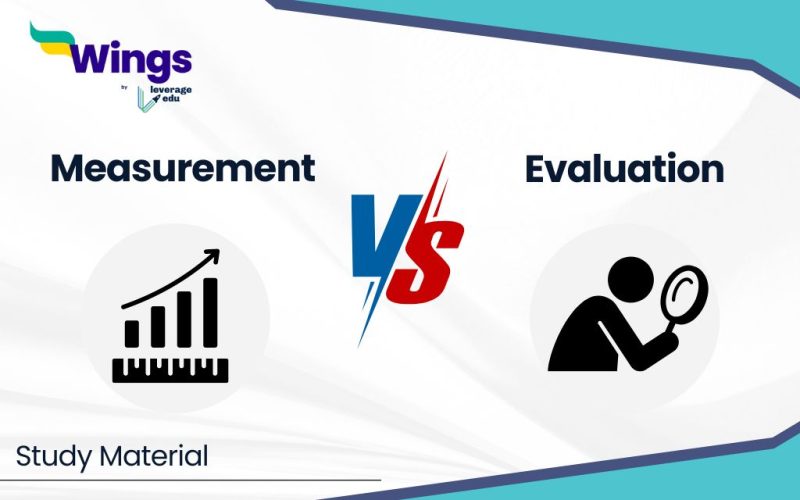Two keywords that frequently come up and capture attention in the world of academics and business are measurement and evaluation. Each has a unique role, and occasionally the distinctions between them can become hazy. However, whether you work in business, education, or research, knowing the difference between measurement and evaluation is crucial to efficient management.
A methodical process for determining an object’s properties is measurement. It defines an object’s height, weight, density, width, and speed, for instance.
Evaluation facilitates the process of forming opinions about efficacy, tactics, methods, strategies, and other aspects of teaching. This blog article, however, will go over the difference between measuring and evaluation.
Table of Contents [show]
What is Measurement?
Measurement is the process of assigning a set of numbers to each group of objects—persons or commodities—in accordance with recognised guidelines or standards and providing a description using common language, terminology, and symbols to indicate the object’s status. Measurement in education refers to the quantitative evaluation of a student’s exam performance.
It is a mechanical procedure that involves utilising the right evaluation tools to assist in the methodical analysis of the features. The variable is changed into a variate, which helps with deductions. For example, IQ is used to measure intelligence, and scores are used to measure the outcome variable.
Also, it helps in highlighting the positives and negatives of a student and comparing various student performances.
Also Read: What is the Difference Between Paralegal and Lawyer?
Points to Remember Regarding Measurement
- In order to determine size, amount, or number, measurements can be used to gather data using a quantitative figure.
- It aids in performance evaluation in situations where an objective assessment is the main factor, such as when comparing test results and the time difference between two places.
- When taking tests to find out one’s personality, IQ, or average gaming score, measurement is useful.
What is Evaluation?
The act of assigning value to the measure is called evaluation. It is a methodical, ongoing process that involves following established guidelines while analysing the results of measuring an object, person, or activity’s features. Additionally, based on the attribute, the relative position of the person, item, or activity is determined.
In evaluation, what we actually do is make decisions about what is appropriate, worthwhile, or attractive. In the context of education, evaluation refers to the general appraisal of a student’s development in relation to:
- Defined objectives
- Efficiency of teaching and
- Effectiveness of the curriculum
It functions within the system as an “inbuilt monitor,” reviewing the student’s progress in learning at different times. Additionally, it offers input on a range of facets of the educational framework, including teacher preparation and student development.
Points to Remember Regarding Evaluation
- The evaluation exhibits a lack of accuracy as well as an emotional component. It’s thought to be philosophical.
- Evaluation is a method of behaviour assessment that takes into account an individual’s biological rhythms, preferences, dislikes, inclinations, and genetic composition, among other things.
- When the numerical data from the measurement is analysed to yield descriptive findings, comprehensive evaluation takes place. The evaluation includes a number of techniques that knowledgeable staff members apply to pinpoint outcomes with additional value.
- Unlike measurement, evaluation rates a student’s skills and achievements in relation to the initial objectives, thereby determining their true worth.
Difference Between Measurement and Evaluation
As mentioned, it is important to know the difference between measurement and evaluation when checking out the progress. Let’s dive in detail to check them:
| Measurement | Evaluation |
| Data-oriented | Judgment-oriented |
| Quantitative | Often Qualitative |
| Provides raw data | Interprets and contextualizes data |
| Uses standard scales | Uses criteria or standards |
| Direct process | Indirect process |
| Mostly objective | Involves subjective judgement |
| Immediate and specific | Involves comparison and relation |
| Reflects performance | Assesses worth or value |
| Tells ‘what is’ | Tells ‘what should be’ |
| Can stand alone | Relies on measurement data |
Also Read: What is the Difference Between Length and Width?
Why Measurement and Evaluation Matter?
Measurement and evaluation are important because they demonstrate how well a process of learning and growth functions, which helps teachers plan their lessons for the next steps.
Furthermore, measuring provides a solid basis for evaluation as it provides an actual point of comparison for the objects. Modifying the teaching and learning process and the curriculum both depend on evaluation.
Examples to Understand
Now, when we look at both table, a proper measurement is given for the weight, i.e., 42kg. Looking at the second table, we understand that the evaluation has 3 criteria based on different measurements where; 20kg – 30kg will be considered thin, 30kg – 40kg will be considered average, and 40kg – 50kg will be considered fat.
| ATTRIBUTE | MEASUREMENT |
| Weight | 42 kg |
| Running speed (100 meter) | 40 seconds |
Similarly, according to the table and measurement shown, running speed (100 meters) with 30 to 45 seconds will be fast speed, 46 to 55 seconds will be average, and 56 seconds and above will be slow speed.
| 20kg – 30kg = Thin 30kg – 40kg = Average 40kg – 50kg = Fat | 30 to 45 seconds = Fast 46 to 55 seconds = Average 56 seconds and above = Slow |
Related Posts
FAQs
Among other things, measurement can be used for problem solving, safety, quality control, monitoring, and fitting (design, assembly).
Evaluation typically centers on measuring data. Before you can analyse and draw conclusions, you must first collect objective, quantitative data (measurement). However, traditional measuring might not be necessary for some evaluation methods, especially those that rely on qualitative data.
Indeed, as assessment data is analysed and utilised to create judgements or evaluations, assessments are usually a part of the evaluation process.
This was all about the “Difference between Measurement and Evaluation”. For more such informative blogs, check out our Study Material Section, you can learn more about us by visiting our Indian exams page.
 One app for all your study abroad needs
One app for all your study abroad needs















 45,000+ students trusted us with their dreams. Take the first step today!
45,000+ students trusted us with their dreams. Take the first step today!
